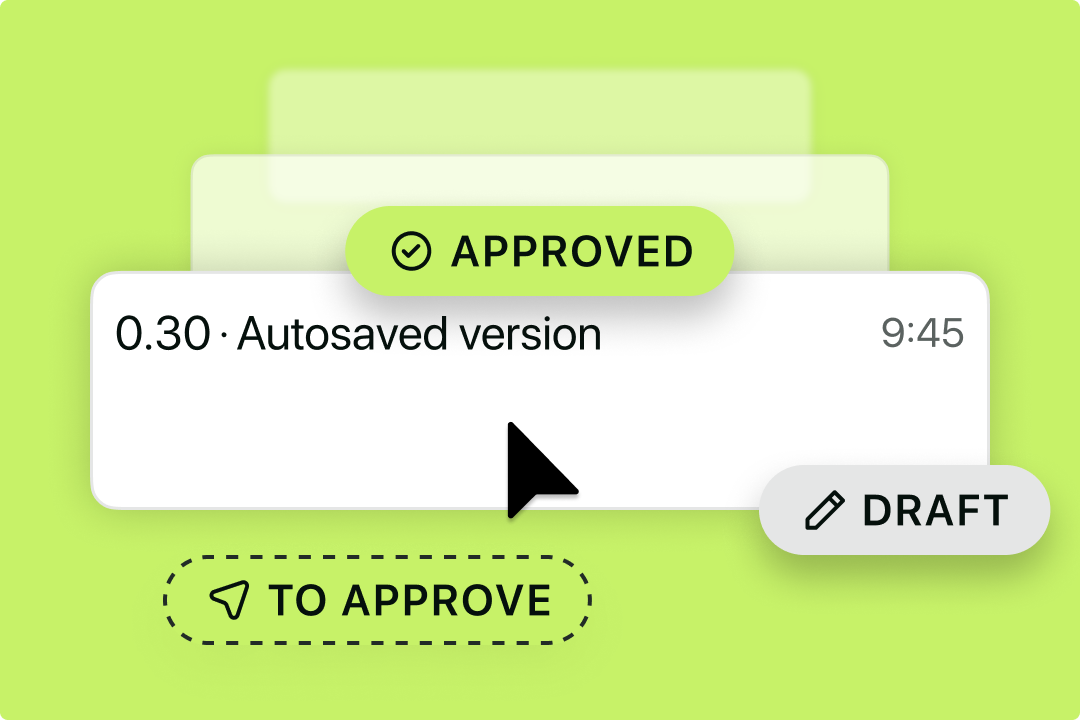Solutions
Customer Support
Resources
From inconsistent language to poor visibility, contract management mishaps prop up throughout the contract lifecycle. Once these mistakes transform into habits, they become difficult to reverse, particularly as a scaling business.
Left unchecked, these mistakes can hinder revenue growth. This is because contracts are key to recognising revenue, meaning that any hiccups within your contract process can have a big impact on your bottom line.
But what are these contract management mistakes, and how can you avoid them before they escalate?
To help, we’ve listed the eight most common contract management mistakes we see in 2026, as well as how to prevent them. If you've already identified the bottlenecks in your contract workflow and are looking for a solution, then hit the button below. If not, read on.
One of the most common contract management mistakes observed within businesses is inconsistency when drafting contracts. This can manifest itself in different ways.
More often than not, this means the inconsistent use of certain language, which can result in unapproved language and terms being introduced into business contracts, causing uncertainty and confusion. It also takes the form of commercial teams introducing new contract terms that introduce unnecessary risk and create disparity across legal agreements.
Without pre-approved language and standard clauses in place, creating contracts not only becomes extremely time-consuming but also increases the risk associated with certain agreements, which can prove costly in the long run.
The best way to ensure your business doesn’t fall into this trap is to implement contract templates, where pre-approved language and clauses are baked into the contract, providing commercial teams with less flexibility to pick and choose inconsistent terms.
It’s possible to create these templates as documents in Word. However, Word wasn’t created with contracts in mind, so the platform doesn’t accommodate these templates as effectively as a contract tool like Juro does.
By comparison, Juro’s automated contract templates enable legal teams to create contract templates and roll these out across the business with ease. Juro’s conditional logic functionality enables legal teams to bake certain terms and clauses into the contract depending on the values entered in by commercial teams.
{{quote1}}
For instance, if a contract value is over a certain threshold, legal teams can automate the addition of certain clauses into the contract. This gives legal control over the contents of a contract, without needing to waste time drafting it themselves.
Another significant mistake made when managing contracts is failing to get the relevant contract stakeholders involved, particularly at the negotiation stage.
Unfortunately, it’s not unheard of for legal to leave commercial teams like finance, HR, sales and procurement out of the contract process until near the end of a negotiation. But in doing so, they could be neglecting the specific needs of these teams, as well as the long-term strategic objectives of the business.
But why does this happen? Well, legal teams are often wary of introducing too many parties to collaborate on a contract, as it could result in greater risk. There’s also the fear that it becomes unproductive, and that the back and forth can result in longer turnaround times for contracts.
But this isn’t necessarily true. Legal teams dedicate a large portion of their time to low-value work, like negotiating these standard contracts when they could have passed them on to the commercial teams instead.
In fact, by trying to manage contracts alone, legal often end up blocking the contract’s progress, which can actually cause delays for other business functions - particularly if commercial teams are only notified of their obligations at the last minute.
What most businesses are yet to recognize, is the value that can come from enabling commercial teams to self-serve on contracts - including at the negotiation stage.
By doing this, legal teams can move away from owning the entire contract process for simple contracts, and return to higher-value work. It can also help these contracts get to ‘yes’ faster, as the wider business can quickly and efficiently create contracts without having to wait for the legal team to have availability first.
{{quote2}}
Not to mention that it allows commercial teams to collaborate on contracts throughout the business, empowering all stakeholders to have their say on the contract terms that are most relevant to them.
With a contract automation software like Juro, legal teams can set up contract templates for commercial teams to use. All the business teams need to do is fill out a simple Q&A flow and the contract is automatically populated with the right information.
These self-serve workflows enable legal teams to retain control over the most important parts of a contract, whilst also enabling commercial teams to speed up the contract lifecycle.
Not only that, but thanks to Juro's conditional logic feature, legal teams can bake fall-back clauses into contract templates and set up certain conditions. This ensures that legal gets the final say on a contract before it can get sent out for signing. This security is something that platforms like Word simply can’t provide.
The next contract management mistake is something that almost all businesses will relate to: missing important deadlines.
Most businesses will have experienced being locked into renewed contracts simply because they missed the deadline to cancel. Built-up, these missed renewal dates can affect your bottom line and create frustration within your business.
Without a robust contract tracking system in place throughout your business, important obligations get overlooked, teams miss major contract milestones, and contract compliance becomes a real nightmare.
Fortunately, there’s a simple solution to this problem: contract renewal reminders.
Most contract management software will provide functionality that notifies you of upcoming contract deadlines, whether they’re renewals, expiration dates, or even due dates.
This prevents your business from getting locked into new contracts you never intended to, and it ensures that your legal and business teams are aware of their contractual obligations and what’s expected of them.

Making your teams aware of upcoming contract milestones can also help them to manage customer relationships better and project revenue more accurately.
For instance, if the customer success teams have an early heads up about contracts nearing an end, they can invest more resources into customer retention. On the flip side, if contracts aren’t going to be renewed, this can be accounted for earlier in revenue projections.
Juro’s contract repository collects information like contract terms and renewal dates as you create your contracts, meaning you won’t have to waste time tagging and recording this data manually.
These dates are then recorded in Juro, where you can set up customizable notifications to remind you of important dates and ensure you never miss another renewal.
Contracts can take a long time to reach signature, and with most businesses switching between up to five different tools, is it any surprise?
This is a contract management mistake most legal and business teams don’t even know they’re making, yet it’s probably the most detrimental.
In a manual contract workflow, most contracts are created in Word, shared and negotiated over email, signed using a separate eSignature tool (or worse, using wet ink), and then saved in a shared drive. If you’re lucky, someone might even extract the contract data and add it to an Excel spreadsheet.
But just imagine how much admin and friction this process creates for the business. Not to mention how difficult it is to track the process of a contract in this workflow. Who is it with? How long has it been there? What’s blocking it? Who even knows?
With so much back and forth between different tools, it’s no wonder contracts lose momentum. In some cases, they’ll never even see a signature.
The solution, therefore, is quite obvious. For better contract management, businesses need a contract tool that allows businesses to manage contracts from start to finish, all in one place. Fortunately, Juro can do just that.
Juro is the only platform that truly enables you to process contracts end-to-end with one solution. Users can create, review, negotiate, approve, sign and store contracts seamlessly without ever needing to leave the platform.
This removes bottlenecks, provides greater visibility into the status of a contract, and makes it quick and easy to find the most recent and accurate version of a contract.

It also eliminates the need to pay for multiple different tools, unlike most contract management solutions which must be integrated with eSignature solutions like DocuSign (or DocuSign alternatives) in order to get contracts over the line.
Another common contract management mistake made by businesses is that they view contracts as being one-dimensional.
Often, businesses use contracts as a legal formality or an administrative process. What they don’t recognize is the value that a contract has beyond just formalizing a new business relationship.
This means that the data contained within contracts typically gets neglected. Post-signature, contracts are usually signed and filed away, either in shared drives or filing cabinets. But this contract data can tell you a lot about your processes and where they could be improved.
{{quote3}}
For instance, it can tell you which terms are most fiercely negotiated, whether to upsell and renew existing agreements and where contracts are most frequently blocked, and why.
Businesses are quick to disregard this data, giving those that do utilize it a competitive advantage that involves better business relationships, faster contract workflows, and more effective contract negotiations.
So how can you ensure you’re not missing out and start capturing your contract data? The quickest and most efficient way to capture contract data is to built your contracts with structured data to begin with, which can be done using contract automation tools.
For more detailed advice on how to do this, check out our guide to capturing contract data.
Similar to the point above about not making contract data accessible enough, it’s also common for businesses to lack visibility throughout their contract process. This means that legal and business teams are often unaware of where a contract is in the lifecycle, where it’s stored, and who’s working on it.
This happens because there are often multiple versions of the same contract, and these contracts are stored across different shared drives and files, making them difficult to locate.
This lack of visibility can create confusion within the business. Sales teams aren’t sure how far away a sales contract is from getting signed, HR teams don’t know whether a candidate is willing to negotiate the terms of their employment contract, and finance teams can’t project revenue as accurately as they’d like.
The best way to resolve this is to store contracts in a more consistent and secure way. This is best achieved by implementing contract software with a data-rich contract repository.

Another solution is to use a contract tool that helps legal and business teams recognize where a contract is in its lifecycle. For example, Juro creates a detailed audit trail for contracts created in the platform, and this audit trail shows who made which changes as well as what they were.
Not only that, but you can also filter contracts by their status by customizing your dashboard. This allows you to see which stage contracts are at and where they’re being blocked.
Losing version control is a problem that in-house lawyers are all too familiar with. With so much back and forth between counterparties and internal teams, it can be hard to identify which version of a contract is the final one.
With this comes additional problems, like not knowing whether you captured all of the necessary changes during a negotiation, or sending off a copy of the contract for signing that hasn’t been approved.
Having poor control over your contract versions can create risk and jeopardize your position as a business, and it’s one of the most damaging contract management mistakes businesses make.
One way to maintain control over your contract versions is to store them all in one place and use a consistent naming system. However, with contracts moving between Word files to email and then shared drives, this can be difficult to implement.
It’s far easier for businesses to implement a contract software that allows visionary legal counsel and the teams they enable to agree and manage contracts in one unified workspace. With Juro, parties can collaborate on a contract in real-time using Juro’s contract editor.
They can tag parties, leave comments and redline contracts without needing to save the file and email it to the counterparty. Instead, these changes happen instantaneously and parties are notified of any changes in real-time.

Even today, one of the most common contract management mistakes businesses make is relying on outdated signing methods like wet signatures to get contracts over the line.
With an increasing number of business relationships developing cross-border, businesses that rely on wet signatures are making it difficult for their clients to finalize agreements.
When dealing with customers that aren’t local, wet ink signatures require a contract to be emailed over, saved as a PDF, printed, signed in pen, scanned and then returned via email. But this is a tiresome and unnecessary process, and one that slows deals down.
Swapping wet ink signing for electronic signatures can eliminate these unnecessary administrative tasks and enable parties to sign contracts in seconds, with no printer or paper required.

Not only is this ideal if you’re looking to become a paperless office, but it also reduces friction in the contract workflow by making it quicker and easier for both parties to sign a contract. This, in turn, increases the likelihood of a prospect signing at all.
Juro enables users to sign contracts electronically in the same workspace they created and negotiated their contracts in, making it even easier than the solution provided by most other eSignature providers.
It sounds obvious, but if there are pain points within your contract process, you need to face them head-on.
Ask around in your organization and engage with other departments to identify problem areas and understand the root causes of the inefficiencies.
Where are contracts sitting for the longest? Who is blocking them from progressing? Where is this friction occurring? Why? Do certain stages of the contract lifecycle require a lot of manual work? Are certain tools not meeting your needs?
Once you’ve identified exactly where bottlenecks are occurring within your current process, it’s far easier to make informed decisions about how to improve your contract workflow.
From inefficient signing processes to loss of version control and friction when using multiple tools, all of these are problems that our CEO and co-founder, Richard, was familiar with from his career as a lawyer.
Since Juro’s contract automation software has been designed with the problems legal and business teams face in mind, it’s unsurprising that most common contract management mistakes can be resolved using end-to-end legal software like ours.
Juro automates contract management tasks from start to finish. This makes it quicker and easier for legal and business teams to create and agree contracts in one place and remove bottlenecks throughout the contract lifecycle.
Since a lot of contract management mistakes often stem from a lack of visibility and poor communication between departments, it’s also valuable to codify your contracting processes in a contract playbook of some sort.
This provides you with the opportunity to outline everything from how contracts will be stored to which terms are pre-approved. By providing this information in one place, you can create a single source of truth and ensure the contract process decided by legal is adopted consistently across all commercial teams.

You could even go a step further and automate your contract playbook using contract automation software. This makes it considerably easier for business teams to follow the processes set out by legal as commercial teams don’t need to create contracts from scratch and move between platforms.
Looking for a way to automate your contract workflow and eliminate costly contract management mistakes? Try Juro.
Juro is all-in-one contract automation platform that helps visionary legal counsel and the teams they enable to agree and manage contracts in one unified workspace, resulting in greater consistency and less risk. Hit the button below to find out more.
Lorem ipsum dolor sit amet, consectetur adipiscing elit. Suspendisse varius enim in eros elementum tristique. Duis cursus, mi quis viverra ornare, eros dolor interdum nulla, ut commodo diam libero vitae erat. Aenean faucibus nibh et justo cursus id rutrum lorem imperdiet. Nunc ut sem vitae risus tristique posuere.

